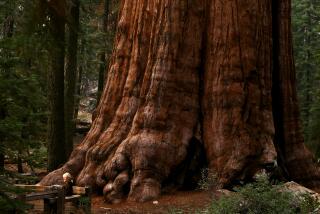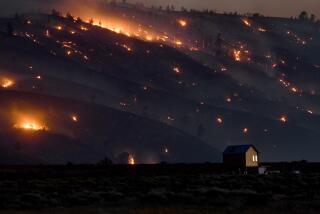When Southern California burns, Long Beach gets the smoke
Long Beach is more than 40 miles from the nearest wildfire raging in Southern California. But its air pollution levels surged in recent days beyond the “unhealthy” level set by air-quality regulators.
Because of Southern California’s quirky topography and wind patterns, neighborhoods with no danger of wildfires are often the ones most affected by wind-driven smoke.
Long Beach sits at the neck of a wind “funnel” that, during strong Santa Ana conditions, carries smoke and ash to the coast from fires in distant mountain and desert areas. Since the wildfires ignited Sunday, the city has suffered some of the region’s worst levels of airborne particulates.
Clouds of smoke “carry enormous amounts of matter, and they fumigate in the area where it is cooler: right next to the ocean,” said Joseph Cassmassi, a meteorologist at the South Coast Air Quality Management District. “You can see plumes of smoke from Santa Barbara all the way to the Mexican border, blowing from the east to the west offshore. It’s very dramatic.”
Particulates, mainly microscopic pieces of soot, smoke and dust, can trigger asthma episodes, bronchitis, pneumonia, heart attacks, strokes and other life-threatening problems. Particulates from wildfire smoke tend to be very small and capable of lodging deep in lungs.
Monday’s level lingered in the unhealthful range in Long Beach, with a noontime peak of 161 on the national air pollution index, before subsiding to moderate levels Tuesday. The trigger for “unhealthy” is 150. The Norco-Corona area registered near 500 before dawn Monday, although its readings dropped to moderate levels later in the day and continued to be moderate Tuesday, according to the AQMD. A level of 200 is considered hazardous, capable of causing immediate breathing difficulties.
Although everyone in the Los Angeles Basin “gets a little dab here and there,” Cassmassi said, the smoke from wildfires driven by Santa Ana winds “tends to wind up in Long Beach at a fairly good frequency.” Similar pollutant levels are likely from Torrance to Huntington Beach, although there are no air-quality monitors there.
“With all the windblown dust and smoke, we can run into situations where the monitors can read up to 900. We’ve seen numbers as high as that,” Cassmassi said. Other nearby areas, he said, may experience lower levels because they lie in a topographic “wind shadow.”
When Santa Ana conditions die down, particulate pollution will concentrate in a more typical pattern, closer to mountain ranges and away from shore areas. Forecasters expect the winds to die down today.
In the meantime, health officials have advised residents of Los Angeles, Orange, Riverside and San Bernardino counties to avoid exercise or exertion outdoors. Children, the elderly and people with respiratory or cardiovascular diseases should take more precautions, remaining indoors if possible.
Schoolchildren in Long Beach were in virtual lockdown for a second day Tuesday. As she picked up her fifth-grade daughter after school at Lowell Elementary School, about half a mile from the ocean, Madonna Cavagnaro said, she saw many of the children lift their shirts to cover their noses.
“The look on the children’s faces was like they were coming out of a bomb shelter,” Cavagnaro said. “There is debris all over our yards, the sky is gray, the air has a stink of fire, and there is a thick layer of gray soot all over the plants, the shrubs and the patio furniture.”
During the 16 days after the region’s wildfires in 2003, hospitalizations for asthma in Southern California increased 34%, according to a new study by UC Irvine environmental epidemiologist Ralph Delfino. In addition, bronchitis increased in preschool-age children and the elderly, and pneumonia cases were up, Delfino’s study showed. Hospitalizations from cardiovascular problems also increased, although not as much as respiratory ailments.
Symptoms can come days later, when the cumulative effects take a toll on airways, lungs or hearts.
In Long Beach, particularly near the ocean, some people said they coughed, had headaches and felt their eyes burning just from walking their dogs around the block.
Joanne Irish, who lives about half a mile from the ocean in Long Beach, said her children, ages 10 and 13, “had horrible headaches yesterday, starting about midday.”
Dr. Helene Calvet, Long Beach health officer, warned residents, especially those with asthma, other lung diseases or respiratory allergies, to take extra precautions during the fires. Youth sports practices were canceled Monday and Tuesday.
The Environmental Protection Agency advises people in smoky areas to close windows, run air conditioners, use air filters and avoid using gas stoves or burning wood or candles, which increase particulates.
More to Read
Start your day right
Sign up for Essential California for news, features and recommendations from the L.A. Times and beyond in your inbox six days a week.
You may occasionally receive promotional content from the Los Angeles Times.






